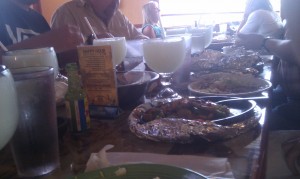Started the day missing the bus but arranged with the hotel for a shuttle to take me in. When I suggested that I’d just walk the mile and a half in the heat the clerk gave me the ‘You are nuts!’ look so just had a seat and started working while I waited for the shuttle to arrive.
 Wandered in about 90 minutes late and got stuck. Here is an image of the board and a description of the three stages: (top, middle and scaffold). At the top left is the geometry we are dealing with showing the layers and the external magnet. In the top two layers there is free streaming of the stem cells and the contaminants. The speed of the two being given by effectively the same expression as on Day 2 with the contaminant cells being identified with \(N=0\).
Wandered in about 90 minutes late and got stuck. Here is an image of the board and a description of the three stages: (top, middle and scaffold). At the top left is the geometry we are dealing with showing the layers and the external magnet. In the top two layers there is free streaming of the stem cells and the contaminants. The speed of the two being given by effectively the same expression as on Day 2 with the contaminant cells being identified with \(N=0\).
In the scaffold, we have something similar with a couple modifications. First, we include a porosity to deal with the fact that there are fibres in the way and including a term that acts like a friction between the cells and the fibres that takes the form $$-kv\frac{1-\phi(z)}{\phi(z)}$$ with \(\phi(z)\) the positionally dependent porosity in the scaffold and \(k\) being a type of friction factor.
There is also a concentration model where we define \(c\) to be the concentration of stem cells and \(c_c\) the concentration of contaminant cells. In the top two regions the concentrations simply satisfy $$\begin{align}\frac{\partial c}{\partial t}+\frac{\partial}{\partial z}(vc) &=0, & \frac{\partial c_c}{\partial t}+\frac{\partial}{\partial z}(vc_c) &=0.\end{align}$$
In the bottom layer, there is the modification that $$\begin{align}\frac{\partial c}{\partial t}+\frac{\partial}{\partial z}(vc) &=-a(t)c, & \frac{\partial c_c}{\partial t}+\frac{\partial}{\partial z}(vc_c) &=-a(t)c_c\\ \frac{\partial c^a}{\partial t}&=a(t)c^a, & \frac{\partial c_c^a}{\partial t} &=a(t)c_c^a\end{align}$$ with the superscript \(a\) indicating ‘attached’ to the scaffold. The \(a(t)\) is taken to be of the form \(A(1-\phi)\).
Next we nondimensionalize the expressions for the velocity. Starting with the full expression, $$\begin{align}\frac{4}{3}\pi\underbrace{\left(NR_m^3\rho_m+R_c^3\rho_f^*\right)}_{\Gamma_2} \dot{v} &= -F_0(z) – 6\pi\mu (R_m+R_c)v – \frac{4}{3}\pi g\underbrace{\left(NR_m^3(\rho_m-\rho_f)+R_c^3(\rho_f^*-\rho_f)\right)}_{\Gamma_1},\\
F_0(z) &= \underbrace{\frac{3\mu_0\chi_m I^2 \tilde{R}^4}{4(1+\chi_m^2)}}_{\Gamma_0}\frac{4}{3}\pi N R_m^3 \frac{z+d}{\left((z+d)^2+\tilde{R}^2\right)^4}.\end{align}$$
Now we take a length scale of \(L\), time scale of \(T\) so that \(z\to L\hat{z}, t \to T\hat{t}, v \to L\hat{v}/T\) then drop hats. Choosing \(T\) to balance the magnetic and drag forces $$\begin{align}\frac{\Gamma_0R_m^3T^2}{\Gamma_2 L^8} &= \frac{9\mu RT}{2\Gamma_2}, & T&= \frac{9}{2}\frac{\mu RL^8}{\Gamma_0 R_m^3}\sim 45 \textrm{s}.\end{align}$$
The nondimensional system for the velocity now becomes $$\begin{align}&\dot{z} =v, \quad \epsilon\dot{v} =-\frac{N(z+d)}{\left((z+d)^2+\tilde{R}^2\right)^4}-v-\textrm{St}, &z(0)&=z_0, \quad v(0)=0\\
&\epsilon = \frac{2\Gamma_2}{9\mu (R_m+R_c)T}\sim 3\times 10^{-7},& \textrm{St} &= \frac{2}{9}\frac{\Gamma_1 g}{\mu (R_m+R_c)}\frac{T}{L}\sim 0.09.\end{align}$$
Finished the day with dinner at the local Mexican restaurant. Margaritas seems to be an appropriate fuel.